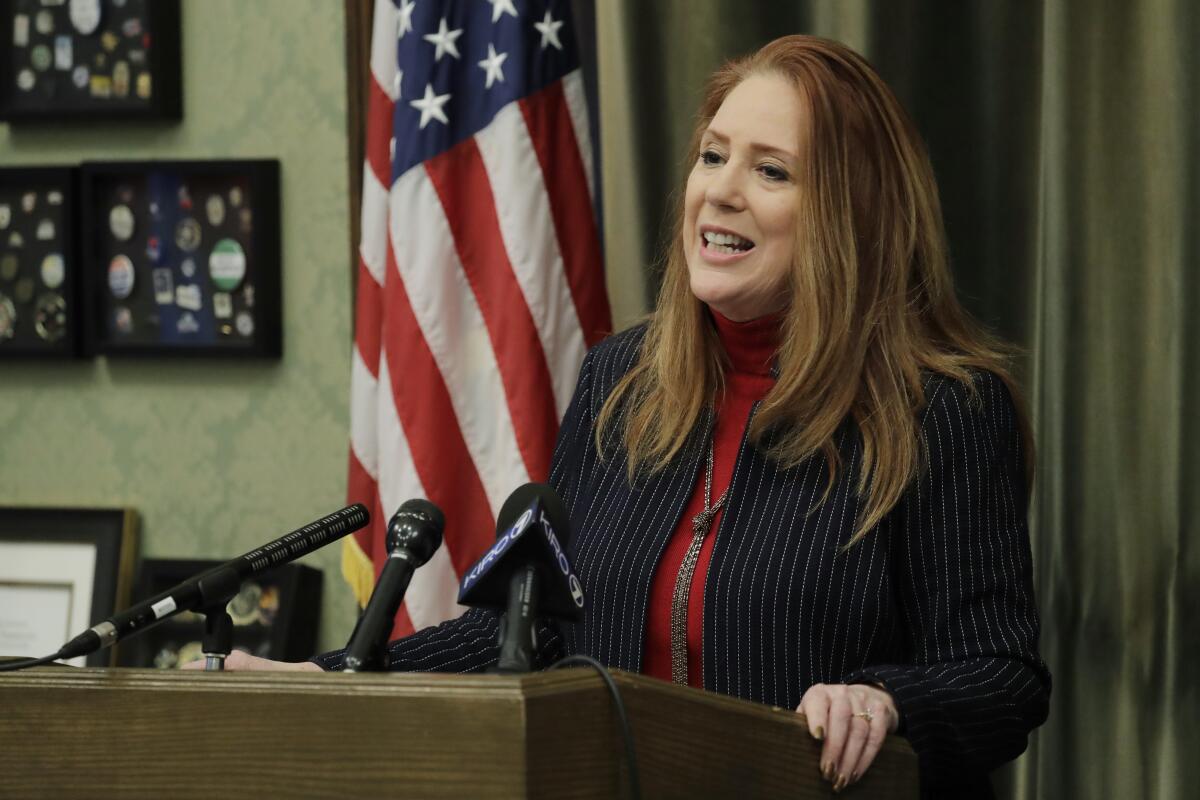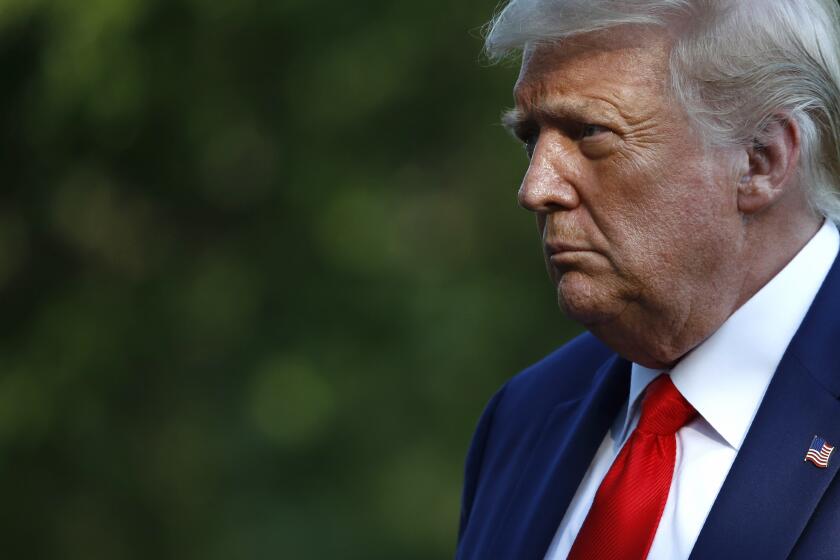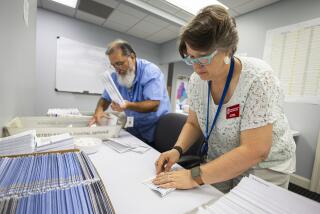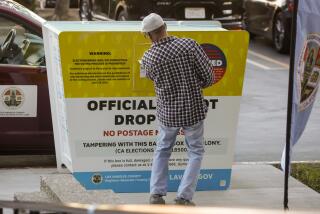‘Every day was nonstop calls’: How a blue state Republican became the face of mail voting

Kim Wyman’s phone started ringing at the end of February.
As the rapid spread of the coronavirus made it clear that the 2020 election cycle would have to accommodate social distancing, reporters and election officials across the country started reaching out to Washington’s two-term secretary of state to discuss the vote by mail system she oversees.
“From March until the end of April, every day was nonstop calls,” Wyman, 58, said in an interview this month.
More than a dozen states postponed their presidential primaries or conducted them entirely by mail, and others loosened absentee rules, allowing people at high risk of COVID-19 complications or concerned about contracting the disease to request ballots. And Congress included $400 million for states to prepare for elections amid the pandemic in its March stimulus bill.
Wyman, known nationally as an expert on mail voting, became a go-to resource for election officials scrambling to adapt. The blue state Republican was elected secretary of state in 2012, a year after the Washington Legislature voted to transition all counties to mail balloting. Before that, she spent two decades working on elections in Thurston County, home to Olympia, the capital.
“Secretary Wyman is unique among secretaries of state in that she was a local election official,” said Amber McReynolds, the CEO of the National Vote at Home Institute and the former director of Denver’s elections. “She has a very clear understanding of the needs of local election officials and she’s always very particular in her attention to that.”
As the pandemic rages on and some in her party attack mail voting, Wyman has become a vocal supporter of the system in interviews, opinion pieces and as co-chair of the circle of advisors for the National Vote at Home Institute.
President Trump, trailing Joe Biden in the polls, suggests delaying the November election.
For voters, the main appeal prior to the pandemic had been convenience, Wyman said. “In Washington state, we haven’t had lines on election day in 10 years, 15 years, for a reason,” she said.
In her attempts to maintain voters’ confidence in the system and to win a third term, her biggest hurdle on both fronts may be President Trump.
During one June speech, Trump claimed with no evidence that states like California wouldn’t send ballots to some Republican voters, that ballots could be stolen from mail boxes, postal service workers could be robbed, signatures could be forged and foreign nations could create falsified ballots. “Mail-in ballots is a disaster for our country,” he said.
Wyman’s top rival in her reelection bid, Democratic state Rep. Gael Tarleton, has tried to tie her to Trump and accused her of not defending the state’s voting system against Republican attacks.
The secretary of state said she hasn’t shied away from her party identity during her statewide runs, but she’s avoided partisanship. “What I learned in my years in the county is that the job is more important than partisan politics,” she said.
Wyman, who grew up in California, cast her first vote in 1980 for Ronald Reagan. “It’s why I’m a Republican to this day, because Ronald Reagan was very inspiring to a young kid from Long Beach,” she said.
She voted in every election until one day in Germany, where her husband was stationed with the Army, she received a mail ballot for an election that had taken place the day before.
“I didn’t realize the significance of it until I started overseeing elections,” she said. “Then you realize how important being able to have your voice heard is and when you’re disenfranchised because somebody makes an error that’s inexcusable.”
From Germany, the couple moved to Washington, where Wyman served as Thurston County’s election manager from 1993 to 2001 and auditor from 2001 to 2013. Her time there overlapped with the state’s transition from the early stages of widespread absentee voting to a virtually all-mail system, and she experienced firsthand the obstacles election officials face as they transition.
During the 1994 primary, her office sent notices asking voters if they wanted to permanently receive absentee ballots ahead of the general election. About 10% said yes — far more than election officials were expecting.
“What we didn’t factor in was, ‘Oh, God, we have to enter all of those in and issue all those people a ballot in the next two weeks.’ We became very aware the hard way that you have to be mindful of that expansion and what that looks like,” she said.
Washington isn’t alone in conducting all elections almost exclusively by mail; Oregon, Colorado, Hawaii and Utah do as well. And every state offers at least some voters the option to request an absentee ballot. Nearly 21% of ballots cast in the 2016 presidential election were mail votes, up from 8% in 1996,according to the Pew Research Center.
Although millions of voters will have greater access to mail voting in November, there’s only so much states with historically low absentee balloting can do in a few months to get to where Washington has arrived over several years. Wyman’s calls with election officials have focused on the logistics of scaling up, she said.
“It’s a whole gamut of how do we gear up, how do you make the transition from going from 3% ballots returned by mail to 50% or 75% or 100%,” Wyman said.
Louisiana’s Republican secretary of state, Kyle Ardoin, said he started talking to Wyman in late February, weeks before the state delayed its April 4 primary. Ardoin said Wyman was an “absolute wealth of information” but was clear about the challenges expanding absentee ballots would pose.
“I think it really confirmed my fear of it,” he said in an interview after the state’s July 11 primary. The state increased mail voting from less than 4% in past elections to 18% in July after adding new coronavirus-related reasons for voters to request absentee ballots, he said.
Now election officials are preparing for the challenges of running the general election during a pandemic that has killed more than 150,000 people in the U.S. In addition to expanding absentee balloting and educating voters, election officials face a campaign against mail voting from the president and his allies.
Brushing aside polls showing his support down amid the worsening coronavirus outbreak, Trump won’t promise to accept the 2020 election result.
Trump’s critics have suggested he is setting the stage to reject the results of the election. The president — who falsely claimed that millions of people voted illegally in 2016 — has refused to say whether he would accept a loss.
There is no evidence of widespread voter fraud, by mail or otherwise. Election officials, including some in red states, have pointed to expanded absentee voting as a secure option to keep voters safe, at times facing pushback from state legislatures. At the same time, public health officials have urged voters to use mail ballots when possible and asked Congress to help states fund efforts to increase mail voting.
“This year round there’s a much bigger pro on the side of vote by mail than there has been in most years, where the argument has been about the benefits and convenience and easier access,” said Brian J. Gaines, a political science professor at the University of Illinois. Gaines said the downside of voting from home is that ballots aren’t secret and voters risk being coerced by roommates or family members.
Supporters of mail voting say that states’ ability to discover cases — such as attempted ballot fraud in a North Carolina congressional election in 2018 or a local election in Paterson, N.J., in May — show that security measures work. “Those were bad actors doing something to voters that they should not be doing, and the system caught it,” McReynolds said.
Wyman compared running an election to running a bank. The state has built in measures to prevent and detect fraud, “but ultimately if someone wants to walk into a bank and rob it, or if somebody really wants to try to perpetrate voter fraud, I imagine they can,” she said.
“And then we have ways to detect it and prosecute it on the back end.”
Signature verification is the “linchpin” of Washington’s election security, Wyman said. Julie Wise, the top election official for King County, where Seattle is located, said her own signature has been challenged twice, including once while she held her current position. Voters have 21 days after the election to verify their signatures after a challenge.
The state is also a founding member of the Election Registration Information Center, a group of 30 states and the District of Columbia that shares voter registration and motor vehicle license lists to help maintain voter rolls.
With the help of the partnership, Wyman’s office announced in May that it had found 142 potential voter fraud cases — out of more than 3.1 million ballots cast in the 2018 general election — involving individuals who may have voted in more than one state or on behalf of a deceased person. Wyman’s office plans to prosecute the cases if counties don’t.
“Is it rampant fraud? No,” Wyman said of the 0.004% of ballots flagged for potential fraud. “Is it acceptable? No.”
Despite the president’s growing attacks on mail voting, the country is likely to see a massive increase in the number of ballots sent to voters this fall. Wyman said the lasting result of the 2020 election cycle might be an increase in the number of states following in Washington’s footsteps: from no excuse absentee voting to permanent absentee ballots to statewide vote by mail.
“When people vote by mail they love it,” she said. “I think you’re going to see a natural migration.”
More to Read
Get the L.A. Times Politics newsletter
Deeply reported insights into legislation, politics and policy from Sacramento, Washington and beyond. In your inbox three times per week.
You may occasionally receive promotional content from the Los Angeles Times.













